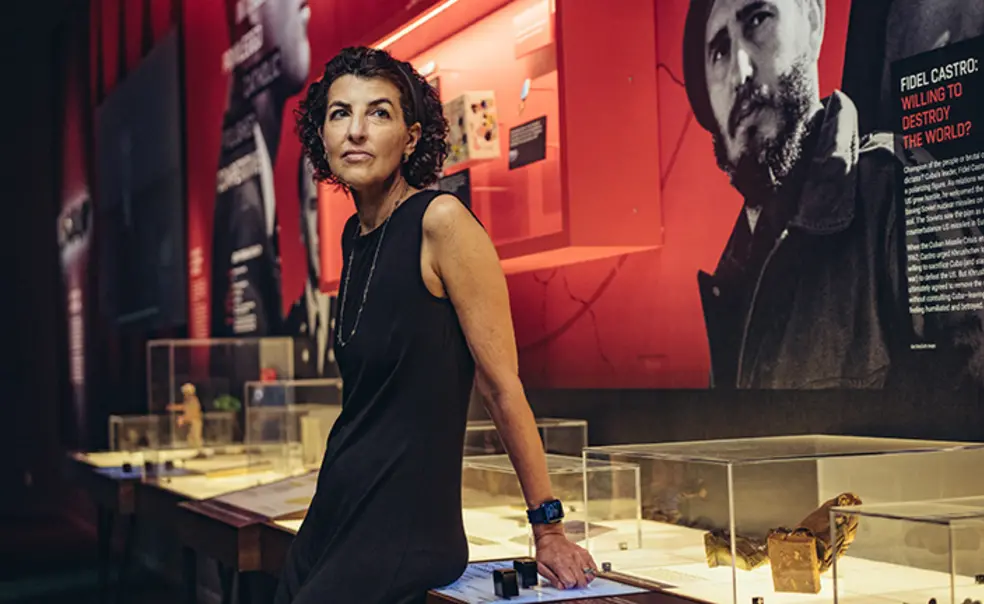Alexis Albion ’92 Educates About Espionage at Spy Museum
As lead curator, Albion teaches the public about the intelligence community
As a senior at Princeton, Alexis Albion ’92 would take the New York Times crossword puzzle to Richard Challener ’44’s lectures in his course on American diplomatic history. Albion took the course as a requirement; her interest was European history, and she was writing a thesis on Napoleon Bonaparte’s 1796 Italian campaign.
Yet Albion went on to spend her career in a field related to the one Challener taught: the study of intelligence. As a member of the 9/11 Commission, she researched what the CIA was doing in the years before the 2001 attacks on the World Trade Center, and for the last decade she has been the lead curator at the International Spy Museum in Washington, which aims to illuminate the world of espionage and intelligence.
After graduating from Princeton, Albion taught English for two years in China, which sparked an interest in international history. In 1996 she started a doctoral program in the subject at Harvard, where a first-year research paper led her to focus on intelligence history. But, she adds, “I found history a very solitary profession, and I realized that only my advisers and my father would read my dissertation. Personality-wise, being a professional historian wasn’t for me.”
In 2002, a fellow graduate student sent Albion a job notice for a historian at the Spy Museum, which was being launched in Washington. “I read the job description and it was me,” she says.
But shortly after she started, she got a call from Philip Zelikow, one of her professors and advisers at Harvard, who in January 2003 was appointed executive director of the 9/11 Commission. Zelikow asked Albion to join his staff, and she spent the next 16 months researching and writing parts of the report the commission produced.
As Albion moved from the 9/11 Public Discourse Project — a follow-on project to the commission — to the State Department and then the World Bank, she stayed in touch with her former colleagues at the Spy Museum. In 2013, Anna Slafer, who had hired Albion out of Harvard, told her that the institution would be moving to a new custom-built building and as part of that process would completely redesign its exhibits.
Attracted by a job where she’d be able to use her creativity, Albion returned to the Spy Museum as lead curator. Albion and Slafer spent two years on the conceptual plan for the new museum and aimed to tell fewer stories in more detail.
Because of 9/11, the U.S. wars in Iraq and Afghanistan, and the Wikileaks and Snowden scandals, Albion says, “We had a public that was much more informed about intelligence than they had been in 2002,” when the Spy Museum opened.
The old museum, Albion says, was focused on “espionage, which is human intelligence collection. We wanted to move into all the other parts of what intelligence agencies do, such as analysis and technical information collection.”
While the museum was planning its move, it tripled its collection thanks to Karen and H. Keith Melton’s donation of their collection of espionage artifacts and archives, the largest privately held assemblage in the world. Albion and her colleagues integrated some of those items into their exhibits.
For example, an ice ax used by a Soviet-trained agent to assassinate Leon Trotsky in 1940 that had a rust stain from a bloody fingerprint became the centerpiece of an exhibit on lethal action, and a bra camera code-named Meadow that was designed by East German Stasi agents so they could inconspicuously conduct surveillance is displayed in an exhibit about Cold War East Berlin.
“Since 9/11, the budgets for intelligence in most Western countries have grown exponentially,” Albion says. “Public oversight of intelligence is something I have become increasingly interested in. Working on the 9/11 Commission was essentially a big public oversight project.”
The Spy Museum, she says, is “proud of taking difficult topics such as intelligence analysis or the balance between secrecy and civil liberties and getting across some of the main ideas and at the same time making them interesting and fun.”












No responses yet